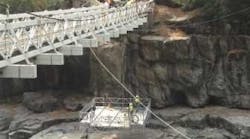A WisDOT official has said that the electronic monitoring of 14 deck-truss bridges in Wisconsin has shown they are safe and functioning as WisDOT expected.
After the I-35W bridge in Minneapolis collapsed into the Mississippi River on August 1, 2007, WisDOT started a plan to electronically monitor 14 deck-truss bridges in that were similar — but not identical — to the Minnesota bridge that had fallen (Western Builder, Nov. 19, 2007).
All 14 of the Wisconsin bridges were visually inspected within two weeks of the tragedy in Minnesota. Just to be doubly certain the bridges were as sound as they seemed, the state decided to also check that loads on the trusses were within the range the bridges were designed to support.
To design a monitoring plan, WisDOT assembled a team that consisted of three consulting-engineering firms, three university engineering departments, and a company expert in electronic monitoring.
Sensors were located at specified positions on the bridges, and data were collected up to 100 times per second for three months.
After carefully analyzing the test results, WisDOT has concluded that most of the loads the bridges carry are less than they were designed for.
The few loadings that were higher came from overweight permitted trucks.
Because Wisconsin's 14 deck-truss bridges have passed the test, all have been put back onto the state's normal two-year inspection schedule.
